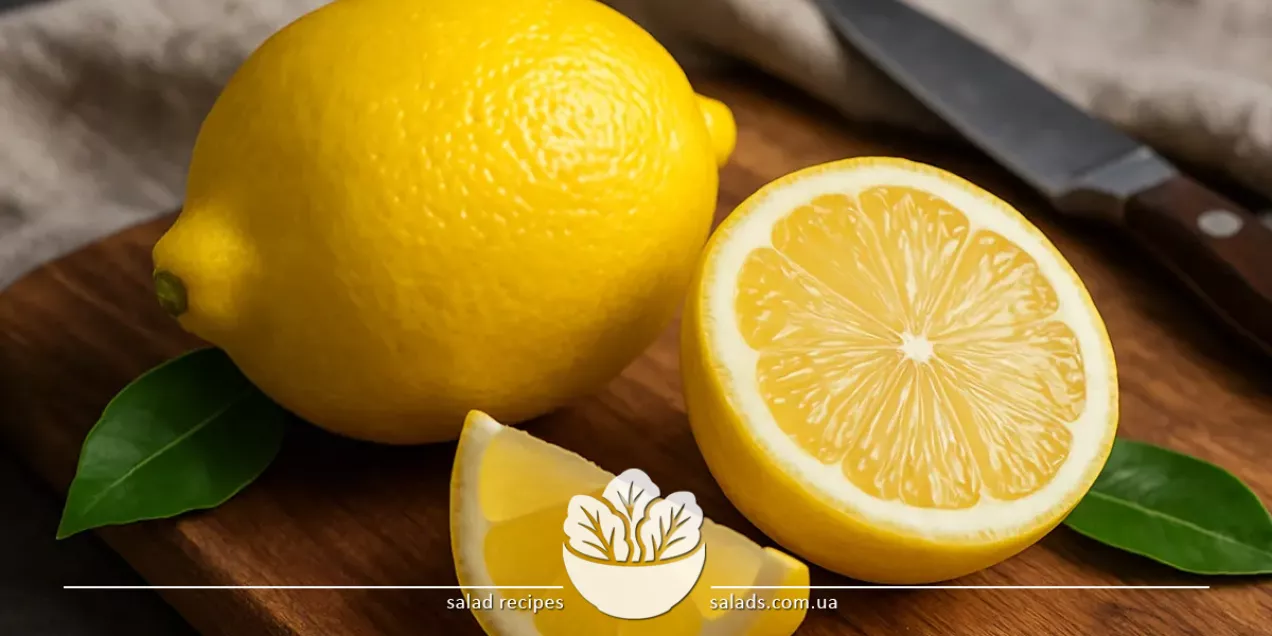Lemon

Lemon is one of the most popular citrus fruits, valued for its intense aroma, fresh-sour flavor, and versatility in cooking. It is widely used in marinades, sauces, desserts, drinks, and also as an accent in fish and meat dishes. Thanks to its high vitamin C content, lemon is a powerful antioxidant and supports the immune system. Both the juice and the zest or slices are added to food. Other forms and varieties of lemons are presented in the category lemons.
Salad Recipes with Lemon
Lemon often serves not only as an ingredient but as a key component of the dressing, bringing freshness, acidity, and pleasant aroma to salads. A particularly popular option is arugula salad with parmesan and pine nuts, dressed with olive oil and lemon juice. In Mediterranean salads, lemon is used to marinate red onions or seafood – for example, in a salad with calamari, tomatoes, and herbs. Lemon pairs well with couscous, fresh vegetables, and mint in a light summer tabbouleh salad. Combined with chicken, apple, or avocado, lemon enhances flavor and preserves the freshness of the ingredients. Lemon is often added to salads with red cabbage or carrots, where its juice helps soften the vegetables. In vegan recipes, lemon zest and juice add brightness even to the simplest combinations, making them more vibrant and appetizing.
The Role of Lemon in Cold Appetizers
In cold dishes, lemon plays several roles: it adds a bold tartness, refreshes the flavor, and helps preserve ingredients due to its natural acids. It is often added to salads, appetizers, seafood, and vegetables – as juice, zest, or slices. Lemon not only enhances flavor but also balances the fat or saltiness of other ingredients. One classic example is seafood salads. In such dishes, lemon serves not only as a flavoring agent but also as a component that highlights the freshness of the ingredients. It pairs especially well with crab sticks, giving them lightness and brightness. Its acidity makes the flavor of the dish more harmonious. That’s why crab sticks combined with lemon juice are often used in festive and everyday salads. This is one of the simplest yet most effective combinations, suitable for various variations: with herbs, corn, cucumbers, or rice. Lemon makes such an appetizer fresh and light – ideal for a summer table or a quick snack.
Classic Pairing with Fish
Lemon is an almost indispensable component in fish dishes. Its juice is used for marinating, removing excess salt, neutralizing odor, or simply as a final touch before serving. The acidity of lemon highlights the delicate texture of the fish, adds freshness and flavor depth, and activates the natural taste receptors. In classic dishes, lemon is often served next to the fish as slices or halves – allowing each person to adjust the acidity. This is typical of European cuisine, especially Mediterranean. In traditional Ukrainian dishes, lemon is also common – for example, in herring salads or appetizers based on marinated fish. A great example of this pairing is salted herring. Its rich flavor and dense texture contrast nicely with the tartness of fresh lemon. Herring pieces are often served with onions and lemon, creating a simple yet harmonious appetizer. This dish is suitable for both festive and everyday meals.
Refreshing Combinations in Meat Dishes
Lemon is equally important in meat dishes – it is used for marinating, softening the fibers, and adding a light touch to the finished dish. Thanks to its natural acids, lemon juice tenderizes meat and adds a pleasant citrus note that reduces the perception of fattiness. This is especially relevant for simple meat ingredients like boiled sausages. Though rather neutral in flavor, they can be enhanced with lemon juice or dressings based on it. For example, salads with boiled sausages become more interesting when a bit of citric acid or fresh zest is added, making the dish less heavy. The pairing with boiled sausages is a great example of how even an everyday ingredient can be refreshed and balanced with lemon. This works particularly well in salads with greens, eggs, hard cheese, or fresh vegetables. Lemon adds lightness and prepares the palate for other flavor accents.
Lemon in Combination with Root Vegetables
Root vegetables like beets, carrots, or celery have natural sweetness and dense texture that contrasts well with the tartness of lemon. Whether fresh or cooked, beets are often served with dressings based on lemon juice, which enhances flavor and improves the absorption of micronutrients. Lemon plays an important role in beet dishes: it neutralizes excessive sweetness, highlights the depth of color, and helps preserve a bright shade after boiling or roasting. This type of dressing is especially useful in salads and appetizers where a fresh acidic accent is needed to balance other components – such as oil, garlic, or sour cream. A classic example is the combination of lemon with beets in salads or vegetable-based appetizers. Lemon dressing gives the beet texture a more velvety feel and makes the flavor more complex. It’s an ideal choice for cold dishes that require aromatic freshness.
Lemon Pairings with Cheese
Lemon is often used in cheese dishes, especially those with pronounced salty or creamy flavors. The acidity of lemon juice balances the fat in cheese, adds freshness, and highlights the core taste notes. It is added both in salad dressings and directly to the dish – as thin slices or zest. One of the best pairings is lemon with feta cheese. This salty, crumbly cheese pairs wonderfully with citrus tartness, especially in salads with fresh vegetables, herbs, or fruit. This combination is typical of Mediterranean cuisine, where lemon often replaces vinegar or other acids in dressings. Using feta cheese with lemon allows the creation of light, refreshing, and aromatic dishes. It can be a simple salad with cucumber and olives or a more complex mix with bulgur or quinoa. Lemon tartness provides contrast, while feta offers a protein-rich and flavorful base.